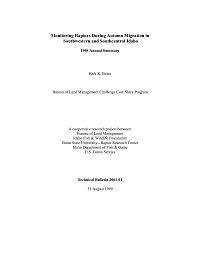Monitoring Raptors During Autumn Migration in Southwestern and South-central Idaho:1998 Annual Summary

Raptor migration counts (RMCs) can sample a wide variety of species, many in large numbers, over a relatively short period of time and are a useful and economical survey technique for detecting long-term trends in species across regions (Titus and Fuller 1990, Bednarz et al. 1990). RMCs can be particularly useful for species that otherwise cannot be easily surveyed using other techniques. Raptor migration counts are conducted at monitoring locations throughout the continental United States (Robbins 1975, Heintzelman 1986, Kerlinger 1989). Most monitoring sites are located along coastlines or mountain ridges where migrating raptors tend to concentrate (Allen and Peterson 1936, Kerlinger and Gauthreaux 1985, Kerlinger 1989). The majority of these locations are located in the eastern half of the country, predominantly in the Great Lakes region, Gulf Coast, Atlantic Coast, and Appalachian Mountains. In the Intermountain West there are only a handful of raptor migration monitoring sites. Specifically, in Idaho and Nevada there are only two monitoring sites, one in each state. During the 1997 autumn migration period, we conducted a pilot raptor monitoring effort at sites in southwestern and southcentral Idaho (Bates 2000). In autumn 1998 we continued our pilot raptor monitoring with increased sampling effort at one primary site, that we sampled in 1997, and two other sites on a limited basis. Also, we identified, accessed, and sampled three other locations to assess their utility for monitoring raptors during autumn migration.
